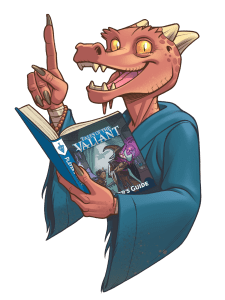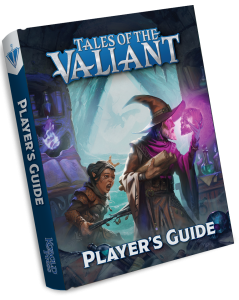
Ask Jiro presents an assortment of kobold scribes and sages to clarify Tales of the Valiant RPG rules and confirm errata sleuthed out by the ToV community!

Since the announcement of ToV, the dynamic community on the Kobold Press Official Discord has been a vital asset. They’ve helped shape the direction and momentum of the game. If you haven’t already joined this diverse, dedicated, lively community, head over and get involved! Your voices, ideas, and opinions are welcome!
This month’s queries are about the Player’s Guide, and getting you up to speed on errata that has been pointed out to us (and that we found ourselves!). Get the game now in hardback and pocket edition!
frogprince392 is afire with good questions!
The Player’s Guide and Monster Vault mention many things that cause something to be ignited. Is there a rule for what happens when something is ignited?
ANSWER!
To answer your broader question: no, there isn’t one, specific rule for when something catches fire or is ignited. I can see why you could wonder that, since the game has specific, defined mechanical terms for many other common words such as “stunned.” It has six levels of “exhausted!” However, ignited, as a game term, doesn’t have a strict mechanical definition. It means a thing that was subjected to fire damage might catch on fire itself and keep burning.
If an effect causes a creature or object to be ignited and doesn’t specify what that means, use this as general guidance. The effect that causes something to be ignited or to catch fire typically describes what happens to it when caught in the effect. Most often, a creature or object that has been ignited takes one die of damage of the type that caused the ignited effect (almost always fire damage) at the start of each of its turns until the fire is extinguished. Extinguishing it typically takes an action by some creature, either the on-fire creature or some one else. Other reasonable effects like the gust of wind spell or dousing with water can also extinguish fire.
cosypower6 ponders spellbooks and rituals
The Player’s Guide states that rituals can be added to a wizard’s spell book like any other arcane spell. Does this mean that a wizard can actually know more rituals spells then what the chart says for Rituals Known? So, if a 1st level wizard found a ritual spell scroll and added it to their book, would they still gain a new ritual when they hit 2nd level?
ANSWER!
That is correct! Wizards are unique in their ability to learn rituals (and spells!) beyond what is given in the class progression table.
Any rituals a wizard learns and adds to their spellbook doesn’t count against the number of rituals they know or automatically learn via the class progression. A wizard still gains new rituals on schedule according to the class progression table, regardless of the number of rituals they currently have in their spellbook.
Errata Corner!
Here, we discuss minor updates and corrections, which will appear in future errata updates on the Errata page. We might also mention errata that already appear there, but we thought they deserved calling out. We typically update the Errata page once a year in the spring, and this corner provides some of those smaller corrections early.
Player’s Guide
Traveler’s Clothes versus Common Clothes: The criminal, homesteader, maker, and rustic backgrounds incorrectly list traveler’s clothes in their equipment section. Those backgrounds provide common clothes, not traveler’s clothes. Feel free to do some traveling in them, though.
Ritualist Talent Multiple Times: The Ritualist talent can be taken multiple times, but you must choose a different source of magic each time.
Monster Vault
Mephit Nature: Mephits are true elementals and don’t require air, food, drink, or sleep—no matter how much your mephit familiar begs for treats at dinnertime.
Sneaky Astral Destroyers: The astral destroyer somehow sneaked onto the Monstrosity table in Chapter 3. It belongs on the Aberrations table, which is where we will coax it with delicious chunks of worlds. Don’t worry; the worlds are already dead. Mostly.
Game Master’s Guide
Templates with Different Damage: The Element-Infused template and the Shadow template each state the creature’s attacks deal half their normal damage and half a new type of damage. These templates should instead state that they allow the creature to deal either type of damage with their attacks. For example, the shadow dire wolf in the Shadow template example should deal cold or piercing damage with its Bite attack, whichever the dire wolf chooses, rather than half the damage as piercing and half the damage as cold. No one wants to cut a die in half just to roll damage for a creature!
